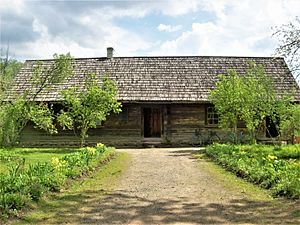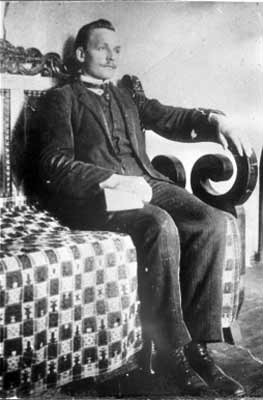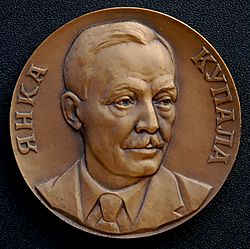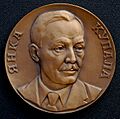Yanka Kupala facts for kids
Quick facts for kids
Janka Kupala
Янка Купала |
|
|---|---|
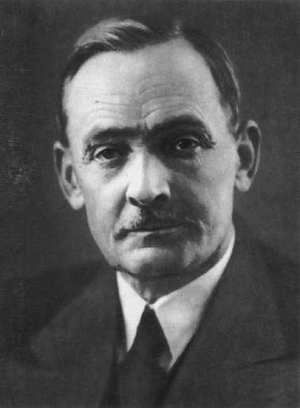 |
|
| Born | July 7 [O.S. June 25] 1882 Viazynka, Minsk Governorate, Russian Empire |
| Died | 28 June 1942 (aged 59) Moscow, Soviet Union |
| Occupation | Poet and writer |
| Nationality | Belarusian |
| Period | 1903–1942 |
Yanka Kupala, also known as Janka Kupała, was a very important Belarusian poet and writer. His real name was Ivan Daminikavič Lutsevič. He used "Yanka Kupala" as his special writing name. He was born on July 7, 1882, and passed away on June 28, 1942.
Contents
The Life of Yanka Kupala
His Early Years
Yanka Kupala was born on July 7, 1882, in a small village called Viazynka. His family had a long history, but they were not rich. Both his parents worked as farmers on rented land.
His grandfather was even forced to leave his home by a powerful family. This sad story later inspired Kupala's play, 'The Ravaged Nest'. Young Ivan had to help his family earn money. After his father died in 1902, he became the main provider.
He took on many different jobs. He worked as a tutor, a shop assistant, and a record keeper. He even worked at a local distillery. Even with all this hard work, he found time to learn on his own. He read almost all the books from his father's library. He also finished local school and became a qualified teacher.
Yanka Kupala took part in the 1905 Russian Revolution. From 1908 to 1909, he lived in Vilnius. He worked for a newspaper called Nasha Niva. During this time, he wrote his famous poem 'Who goes there?'. This poem later became a well-known song and a symbol for Belarusians.
He continued his studies from 1909 to 1913 in St Petersburg. In 1915, he studied for a year in Moscow. His studies were stopped by the First World War. In 1916, Ivan joined the military. He worked in a road-building unit in different cities like Minsk and Polotsk.
His Family and Love Life
Two women are often remembered when people talk about Yanka Kupala's personal life. One was his wife, Vladislava Stankevich. The other was Paulina Miadzyolka, who inspired him.
Paulina Miadzyolka met Yanka Kupala in 1909. She wrote in her memories that Kupala liked to joke. He asked if there were many beautiful girls in Vilnius. Paulina said she was not happy with his playful talk.
This meeting with Paulina Miadzyolka made a big impression on Kupala. Four years later, he named his new play Paulinka after her. He even asked Paulina to play the main role. She accepted and they stayed in touch.
Kupala married Vladislava Stankevich in 1916 in Moscow. Paulina Miadzyolka wrote that she only found out about their marriage a year later.
Yanka Kupala and Vladislava Lutsevich were married for over 25 years. When the poet died in 1942, his wife was very sad. She decided to dedicate her life to keeping his memory alive. Vladislava Lutsevich created and became the director of the Museum of Yanka Kupala in Minsk.
Yanka Kupala's Writing Career
Kupala's first serious poem was Ziarno. He wrote it in Polish around 1903–1904. His first poem in the Belarusian language was "Мая доля," written on July 15, 1904. His first published poem, "Мужык" ("Peasant"), appeared in a newspaper in May 1905. Many of his poems were then published in the Belarusian newspaper Nasha Niva from 1906 to 1907.
Life in Vilnius and St. Petersburg
Kupala moved to Vilnius in 1908. There, he continued to write poems. That same year, his first collection of poems, Жалейка (The Little Flute), was published. However, the government did not like it. They ordered the book to be taken away because they thought it was against the government.
The order to arrest Kupala was later canceled. But a second printing of his book was also taken away by local officials. To protect the newspaper, he stopped working for Nasha Niva.
Kupala moved to Saint Petersburg in 1909. The next year, he published more works. These included the poem Адвечная песьня (Eternal Song). Another important work was Сон на кургане (Dream on a Barrow). This poem, finished in August 1910, showed the sad state of his Belarusian homeland. Famous writer Maxim Gorky was one of the people who influenced Kupala. In 1913, Kupala left St. Petersburg and went back to Vilnius. He started working at Nasha Niva again.
During the Soviet Era
After the October Revolution in 1917, Kupala's writing became more hopeful. He translated many works into Belarusian. These included the famous song The Internationale and an old epic poem called The Tale of Igor's Campaign. He also worked for the People’s Commissariat of Education. He edited magazines like 'Run' and 'Volny stsyag'.
However, Kupala was sometimes viewed with suspicion by the new authorities. Some people criticized his work, saying it was too focused on nationalism. This difficult time ended after he wrote a public "letter of repentance" in the 1930s. It is believed he was forced to write this letter.
In 1941, Kupala received the Order of Lenin. This was a high award for his poetry collection Ад сэрца (From the Heart). When Nazi Germany occupied Belarus in 1941, he moved to Moscow. Later, he moved to Tatarstan. Even from there, he wrote poems to support Belarusian fighters against Nazi Germany.
Yanka Kupala died in Moscow on June 28, 1942, at 59 years old. He fell down a stairwell in Hotel Moskva. Some people wondered if his death was an accident because of how he fell.
Yanka Kupala's Lasting Impact
Yanka Kupala became a symbol of Belarusian culture during the Soviet era. A museum dedicated to him was opened in Minsk in 1945. His wife worked hard to create this museum. It is now the main literary museum in Belarus.
Hrodna State University is named after Yanka Kupala. There is also a park with a monument to him in Minsk. A theater and a metro station in Minsk are also named after him.
There is even a special area of study in Belarusian literature called 'Kupalaznaustva'. This field focuses on studying Kupala's works.
You can find monuments to Yanka Kupala in other countries too. There is one in Monroe, New York, in the USA. Another monument is in Ashdod, Israel.
In 2020, a movie called Kupala was made. It tells the story of the poet's life.
Images for kids
See also
 In Spanish: Yanka Kupala para niños
In Spanish: Yanka Kupala para niños


